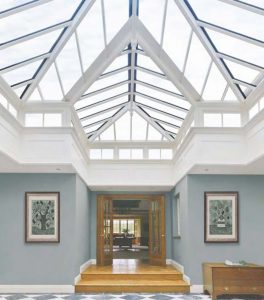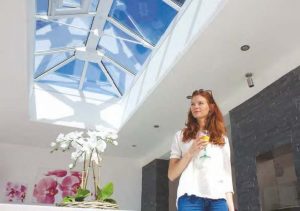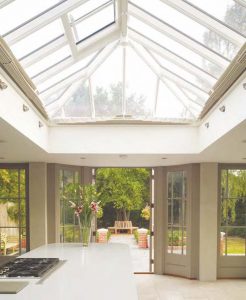Roof Lanterns
If there’s one thing guaranteed to lift the spirits, it’s a bright sunny day. In winter, a short burst of sunshine can give an immense boost to the flagging human system after a period of gloom – and who doesn’t look forward to longer, lighter days?
A recent study at Durham University suggested that “mood and behaviour are strongly affected by light, with prolonged darkness or dull weather leading to lassitude and depression”. Rather than jetting off for the Caribbean as an annual antidote, bringing daylight into your home can be a more permanent alternative to beat the blues.
Draught-proof modern bi-fold doors are a good addition but might not suit your room, and giving up wall-space is a compromise. A roof lantern can be even better – throwing down up to three times more daylight than is let in by a vertical window, and without compromising privacy either.
A roof lantern is a raised architectural skylight set into a flat roof, creating a stylish look as well as a brilliant ambience. Back in the 16th century, they were integral elements in orangeries to encourage plants to grow.
Now they are popular in kitchen-diners, where these days many of us spend a lot of our waking hours. The style, construction and size can vary to suit contemporary and traditional properties; they can include self-cleaning glass, and even have a hinged window to allow fresh air in and food smells out.
The most popular style is the pyramid, but you can have circular, octagonal or rectangular, with domes the most prominent shape and decorative features such as finials an option. Small side (clerestory) windows can be incorporated into the structure, and frames can be finished in a colour to suit your décor – remember, you will see the lantern from inside and outside. Work with your builder to choose double or triple glazing, and minimise roof bars for maximum light.
Frames are often made of aluminium, but wood is, of course, a traditional high-quality alternative depending on budget. Elegant oak is available as a premium material, and some builders use sapele, a reddish-brown African hardwood.
Roof lanterns are required by building regulations to sit on an upstand: a kerb-like construction which ensures waterproofing and safety. There are other regulations relating to loadbearing, insulation and energy efficiency, and fire performance too especially if close to a boundary with another property. You do not normally need planning permission unless the lantern increases your overall peak building height.
As always, find an experienced builder with a specialist architect on hand to discuss your unique requirements – and they will be able to throw new light on your project and into your home.
Posted in: Property



